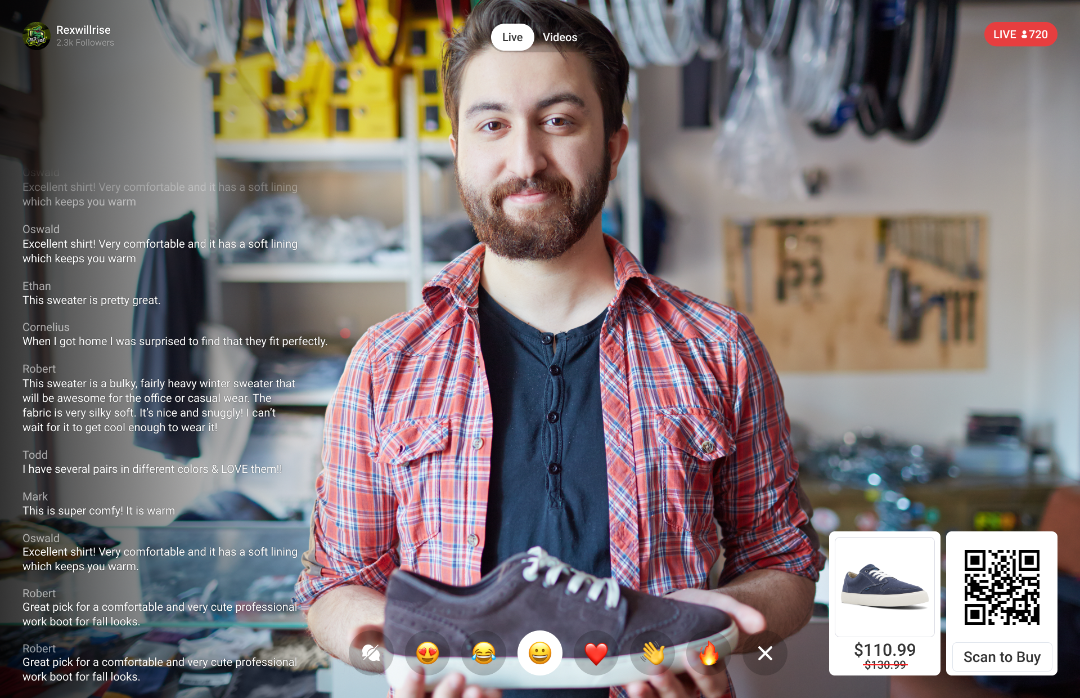“I watch cooking shows on Food Network. If I see a cool cooking gadget, I will buy it almost immediately!”
George commented this in one of my LinkedIn posts.
That’s the whole point of adding e-commerce to ott and streaming tv videos and websites.
You’re watching your favorite show, and suddenly, you spot something you just have to have—a jacket, a piece of tech, or even that fancy coffee maker in the background.
For your customers to be able to click and buy it right then is what combining e-commerce with OTT (Over-The-Top) platforms and streaming TV can do for your business.
Let’s talk about how you can make this happen on your platform.
What’s the Big Deal with OTT and e-commerce?
With more people cutting the cord and moving to streaming services, the opportunity to mix entertainment and shopping has never been bigger.
Adding e-commerce to your OTT platform will transform passive viewers into active shoppers, boosting both engagement and revenue.
How Shoppable Videos Are Revolutionizing Content Monetization
Shoppable videos are at the forefront of this transformation, allowing viewers to purchase featured products directly from the video they are watching.
This blend of watching and shopping isn’t just convenient—it’s powerful.
It boosts conversion rates, keeps viewers hooked, and makes the whole experience more interactive. For OTT and streaming TV providers, it’s a smart move to tap into new revenue streams.
Making e-commerce Work with Your OTT Content
So, how do you blend e-commerce with OTT?
You can integrate e-commerce right into the content, making it a seamless part of the viewing experience with Vimmi.
Vimmi’s video commerce platform allows you to place clickable links, pop-up offers, and even in-video purchases directly into OTT content.
Here’s how you can do it:
1. Interactive Video Elements
Viewers don’t just watch—they interact.
By adding clickable elements like product tags, you can allow viewers to explore and purchase products without leaving the video. This keeps them engaged and drives impulse buys.
2. In-Stream Purchases
Make it easy for viewers to buy what they see. Whether it’s a quick “Buy Now” button or a more detailed in-stream store, keeping the shopping experience inside the video is key.
3. Personalized Shopping Experiences
Use data to make it personal.
Recommend products based on what viewers are watching. If someone’s bingeing a cooking show, offer them kitchen gadgets or ingredients used in the episode.
4. In-Video Product Tagging
Allow viewers to click on items featured in shows and purchase them directly from the video.
5. Interactive Video Ads
Embed interactive features within ads that allow viewers to explore and buy products without interrupting the viewing experience.
6. Shoppable Video Playlists
Create curated video playlists where viewers can shop for featured products as they watch.
7. Integrated Checkout
Simplify the purchasing process by integrating a shopping checkout system directly within your platform.
8. Personalized Shopping Suggestions
Use viewer data to offer personalized product recommendations, enhancing engagement and sales.
9. Affiliate Marketing
Integrate affiliate marketing offers to earn commissions on products sold through your content.
10. Live Shopping Events
Host live shopping events where viewers can purchase products in real-time, creating urgency and excitement.
11. Content-Based Recommendations
Suggest related products based on viewing history, increasing the relevance and likelihood of purchase.
12. Social Sharing of Purchases
Encourage viewers to share their purchases on social media, driving additional traffic and sales.
Why This Matters for Your Business
If you’re running an OTT platform, this isn’t just about making some extra cash. It’s about creating a richer, more engaging experience for your audience. Here’s why it’s worth your attention:
- Increase Engagement: When viewers can shop while they watch, they’re likely to stick around longer. This means more time spent on your platform, which is always a good thing.
- Boost Revenue: Every click, every purchase is more money in the bank. Plus, it opens up new partnerships with brands looking to reach your audience.
- Improve Viewer Experience: No more searching for that cool outfit or gadget. You’re giving viewers what they want, right when they want it.
Getting Started: What You Need to Know
1. Choose the Right Technology
The tech you use matters.
You need a platform that’s built for seamless e-commerce integration.
| Create your FREE account with Vimmi. Start selling with shoppable videos now! Claim Your Free Account |
2. Focus on User Experience
Keep it simple.
The shopping experience should be as smooth as possible.
Don’t overload viewers with too many options or complicated processes.
The goal is to make it easy for them to shop without missing a beat in the content.
3. Collaborate with Brands
Partner with brands that align with your content.
This can create a more authentic shopping experience.
For example, if you’re streaming a fitness show, for example, collaborating with a sportswear brand could be a natural fit.
4. Analyze and Adapt
Once you’ve launched, pay close attention to how viewers are interacting with the e-commerce features.
Use data to tweak and improve the experience. What’s working? What’s not? Keep refining until you find the sweet spot.
The Future of OTT is Here
The line between watching and shopping is blurring, and OTT platforms are at the forefront of this shift. By integrating e-commerce into your streaming service, you’re not just keeping up with trends—you’re setting the stage for the future of entertainment and retail.
If you’re ready to transform your OTT platform into a dynamic shopping experience, there’s no better time to start.
Let’s make your content not just something to watch, but something to buy.
Read the Full Article
To dive deeper into how you can add eCommerce to your OTT and Streaming TV videos and websites, we highly recommend reading the complete article on the OTT Business magazine website.
You can access it here: Adding eCommerce to OTT and Streaming TV Videos and Websites.
